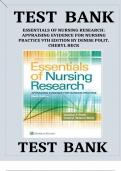Exam (elaborations)
TEST BANK Essentials of Nursing Research Appraising Evidence for Nursing Practice (9TH) by Denise Polit All Chapters
Essentials of Nursing Research Appraising Evidence for Nursing Practice 9th Edition by Denise Polit Stuvia Test Bank Is Available For Download After Purchase. In Case You Encounter Any Difficulties With The Download, Please Feel Free To Reach Out To Me. I Will Promptly Send It To You Through Google...
[Show more]



